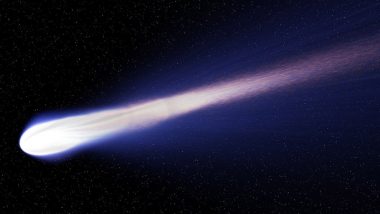January 2025 is not just the start of a new year; it is also bringing many exciting celestial events, some of which are extremely rare. For astronomers, stargazers, and nature lovers, there is a special treat in store! Comet C/2024 G3 (ATLAS), also known as ‘sun grazer’ because of its close pass by the sun, is making its appearance. This comet is expected to reach a peak brightness of magnitude -6.1, which means that it could shine brighter than Venus, the second brightest object in the night sky after the moon. If the predictions about the comet are accurate, it will be a dazzling sight and offer us with a once-in-a-generation opportunity since comets this bright are very rare. Here’s all you need to know. Wolf Moon 2025 Date and Time: What Does January’s Full Moon Mean? Visibility and Other Details of the First Lunar Event of the Year Explained.
What Is Comet C/2024 G3 (ATLAS)?
Comet C/2024 G3 (ATLAS) is a long-period comet that is visible once every 1,60,000 years. The last time it appeared, Earth was likely in the ice age. The comet travels very close to the sun, which makes it hard for most people to see it. There is also a chance that it might not survive its journey. As it moves closer to the sun than Earth, the extreme heat melts its icy core. This creates a glowing cloud around it and a bright, beautiful tail.
Comet C/2024 G3 (ATLAS) Peak Date
Comet C/2024 G3 (ATLAS) will come closest to the sun on Monday, January 13 at 10:17 UTC, which is 03:47 PM IST.
Will It Be Visible?
The comet is expected to shine even brighter than Venus, making it visible to the naked eye. It will be easiest to see from the southern hemisphere, especially in the early morning before sunrise near the constellation Sagittarius. After perihelion, viewing the comet from the northern hemisphere will become harder. However, it will still be visible in the southern hemisphere as it moves into the evening sky.
Comet Viewing Challenges
Comets are unpredictable, and the same closeness to the sun that makes them bright also puts them at risk of breaking apart. Strong solar radiation and gravity can cause the comet to split, making it less bright. Observing the comet will not be very easy. On January 13, when it is at its brightest, it will be very close to the sun from Earth’s view. This makes it hard to see without special equipment because the sun’s glare will hide the comet’s glow. For those determined to witness the rare spectacle, knowing the timing and location is very important.
Comet C/2024 G3 (ATLAS) Viewing Tips
The best and safest time to view the comet will be around January 20, after it moved farther away from the sun. By then, the comet will have dimmed from its peak brightness, but it will be visible during twilight, when the sun’s glare is less strong. Planet Parade 2025 Dates: Venus, Saturn, Jupiter and Mars, 4 Planets To Align in the Sky Throughout January, Know Visibility Time in India & Viewing Tips of Planetary Conjunction.
It is important to use glasses, binoculars, or telescopes with solar filters for safe viewing, especially during the day or when the comet is near the sun. These tools help you see the comet’s coma and tail more clearly.
Even with all the preparations, factors like skyglow, weather, and pollution can still make it harder to see the comet. It is best to go to dark areas away from the city lights to have a better chance of spotting the comet.
(The above story first appeared on LatestLY on Jan 10, 2025 10:42 AM IST. For more news and updates on politics, world, sports, entertainment and lifestyle, log on to our website latestly.com).













 Quickly
Quickly












